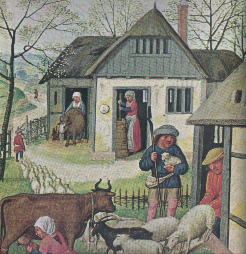
Medieval Construction
Farm Buildings

Farmland and distant woodlots in the Dutch lowlands still marked by only the village church on the horizon.
Stucco plaster on woven stick lathe backing: "wattle and daub" infill was also used on farm buildings, in which peasants lived with their livestock all together sharing one roof. The purpose of the main building was to protect the livestock throughout the winter, as well as the family and live-in farmworkers. Secondary outbuildings were added to house additional livestock and farmworkers if the farm grew in prosperity.

click on picture for bigger image
In this medieval manuscript illustration we can see wooden board and batten vertical siding on the gable ends of the attic assembly. The attic itself is ventillated with gable end vents, to prevent mildew and rot setting in below the thatched roofing.
The roof was made of thick straw thatching, which sheds water very well through many days of heavy rain, but not indefinitely. If the weather is particularily inclement and rain
persists for weeks at a time, the thatch roof will become saturated with water, and leak copiously.
By the time of the more prosperous thirteenth century, many buildings had real chimneys for the masonry firebox inside. On the masonry hearth a large fire could be maintained, not for central heating, but for cooking purposes.
Such buildings rarely had real foundations, but were anchored by vertical mainframe posts dug into the ground, much the same as fence posts. No such buildings survived the rot and decay since medieval times.


Farmland and distant woodlots in the Dutch lowlands still marked by only the village church on the horizon.
Stucco plaster on woven stick lathe backing: "wattle and daub" infill was also used on farm buildings, in which peasants lived with their livestock all together sharing one roof. The purpose of the main building was to protect the livestock throughout the winter, as well as the family and live-in farmworkers. Secondary outbuildings were added to house additional livestock and farmworkers if the farm grew in prosperity.

click on picture for bigger image
In this medieval manuscript illustration we can see wooden board and batten vertical siding on the gable ends of the attic assembly. The attic itself is ventillated with gable end vents, to prevent mildew and rot setting in below the thatched roofing.
The roof was made of thick straw thatching, which sheds water very well through many days of heavy rain, but not indefinitely. If the weather is particularily inclement and rain
persists for weeks at a time, the thatch roof will become saturated with water, and leak copiously.
By the time of the more prosperous thirteenth century, many buildings had real chimneys for the masonry firebox inside. On the masonry hearth a large fire could be maintained, not for central heating, but for cooking purposes.
Such buildings rarely had real foundations, but were anchored by vertical mainframe posts dug into the ground, much the same as fence posts. No such buildings survived the rot and decay since medieval times.


Farmland and distant woodlots in the Dutch lowlands still marked by only the village church on the horizon.
Stucco plaster on woven stick lathe backing: "wattle and daub" infill was also used on farm buildings, in which peasants lived with their livestock all together sharing one roof. The purpose of the main building was to protect the livestock throughout the winter, as well as the family and live-in farmworkers. Secondary outbuildings were added to house additional livestock and farmworkers if the farm grew in prosperity.
In this medieval manuscript illustration we can see wooden board and batten vertical siding on the gable ends of the attic assembly. The attic itself is ventillated with gable end vents, to prevent mildew and rot setting in below the thatched roofing.
The roof was made of thick straw thatching, which sheds water very well through many days of heavy rain, but not indefinitely. If the weather is particularily inclement and rain
persists for weeks at a time, the thatch roof will become saturated with water, and leak copiously.
By the time of the more prosperous thirteenth century, many buildings had real chimneys for the masonry firebox inside. On the masonry hearth a large fire could be maintained, not for central heating, but for cooking purposes.
Such buildings rarely had real foundations, but were anchored by vertical mainframe posts dug into the ground, much the same as fence posts. No such buildings survived the rot and decay since medieval times.

click on picture for bigger image